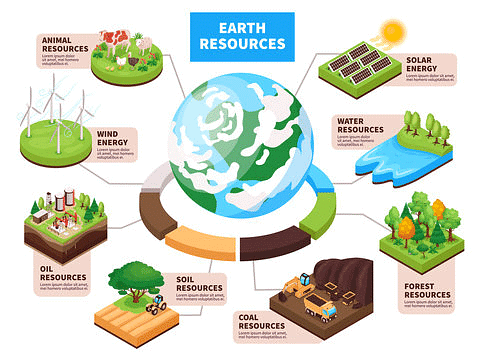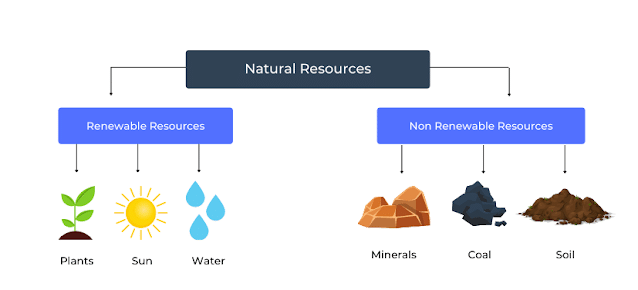Long Question Answer: Natural Resources and Their Use | Social Science Class 8 - New NCERT PDF Download
Ans: All those substances which have some utility or usability are resources for us.
- Utility or usability
- Economic value or any other value
- Time and technology inherent, which can make the substance important for present or future requirements of the people. For example, Discovery of fire led to the practice of cooking, Invention of wheel ultimately resulted in the development of newer modes of transport etc.

Q2: Describe the different types of Natural resources.
Ans: Natural resources are categorised in two types –
- Renewable Resources- Resources which do not depend on human consumption are called renewable resources. These resources get renewed with the use of humans. But there are some kinds of renewable resources that are affected by human consumption such as water, soil and forest.
- Non-renewable Resources- Resources whose stock are limited are called as non-renewable resources. These resources decrease with human consumption. These resources take thousands of years to renew. Examples of such kinds of resources are coal and Petroleum.

- The usage of renewable resources is sustainable,
- The diversity of life on earth is maintained,
- The damage caused to nature by our activities is as low as possible.
Q4: Explain the concept of natural resources, including the conditions required for an element of nature to become a resource. Provide examples from the chapter and discuss how human actions can affect their availability.
Answer:
- Natural resources are materials and substances from nature that are valuable to humans, such as water, air, soil, coal, and timber.
- For an element to become a resource, it must be technologically accessible (e.g., extracting petroleum from under the ocean), economically feasible (cost-effective to extract), and culturally acceptable (not violating sacred sites like groves).
- Examples include trees becoming timber for furniture or flowing water generating hydroelectricity.
- Human actions like overexploitation (e.g., deforestation faster than regeneration) or pollution from industries can disrupt natural cycles, leading to depletion, as seen in melting glaciers due to industrialization and deforestation affecting water security.
- Respect and care for all forms of life.
- Improve the quality of human life.
- Conserve the earth’s vitality and diversity.
- Minimise the depletion of natural resources.
- Change personal attitude and practices towards the environment.
- Enable communities to care for their own environment.
Q7: Mention our duty to maintain and preserve the life support system that nature provides us.
Ans: The future of our planet and its people is linked with our ability to maintain and preserve the life support system that nature provides. Therefore, it is our duty to ensure that.
- all uses of renewable resources are sustainable
- the diversity of life on the earth is conserved
- the damage to natural environmental system is minimised.
Q8: What is the significance of time and technology in making a substance a resource?
Ans: Time and technology are two important factors that can change substances into resources. Each discovery or invention leads to many others. The discovery of fire led to the practice of cooking and other processes while the invention of the wheel ultimately resulted in development of newer modes of transport. The technology to create hydroelectricity has turned energy in fast flowing water into an important resource.
Q9. Discuss the uneven distribution of natural resources and its implications on human settlements, trade, conflicts, and the 'natural resource curse'. Use examples from India and suggest ways to overcome these challenges.
Ans:
- Natural resources are unevenly distributed, shaping settlements (e.g., industries near coal in Jharia create jobs and towns), trade (e.g., Wootz steel from Indian resources fueled empires), and conflicts (e.g., Kaveri River water sharing among Karnataka, Tamil Nadu, Kerala, Puducherry).
- Internationally, wars occur over resources like the Brahmaputra. The 'natural resource curse' occurs when resource-rich areas experience slow growth due to reliance on raw exports without value-added industries.
- In India, this is avoided by developing processing industries. To overcome, invest in technology, skills, and governance for sustainable extraction, fair sharing agreements, and diversification beyond raw resources.
Q10. Elaborate on the responsible stewardship of natural resources, including strategies for restoration of renewables and judicious use of non-renewables. Include case studies from the chapter like Punjab, Sikkim, and the International Solar Alliance.
Answer:
- Stewardship involves using resources wisely for regeneration of renewables (e.g., replenishing groundwater through rainwater harvesting, traditional practices like mulching for soil health) and stretching non-renewables (e.g., transitioning to solar from coal).
- In Punjab, overexploitation during the Green Revolution led to depleted aquifers and chemical pollution; solutions include crop diversification and recharge initiatives.
- Sikkim's 2016 shift to 100% organic farming restored biodiversity, boosted incomes, and used natural pest repellents. The International Solar Alliance (launched 2015 by India and France) promotes solar in sunny countries, exemplified by Bhadla Solar Park in Rajasthan, reflecting India's sustainable energy leadership.
Q11. Analyze the role of traditional knowledge and cultural practices in sustainable resource use, with references to Vṛkṣāyurveda, ecosystem services, and concepts from Indian texts like the Bhagavad Gita.
Answer:
- Traditional knowledge views nature as sacred (e.g., Tulasi puja for wellbeing, arghyam to the sun), promoting mindful use. Vṛkṣāyurveda, an ancient science, recommends soil-specific planting, natural pest management, crop rotation, and moisture-retaining ploughing for sustainable agriculture.
- Ecosystem services, like trees producing 275 liters of oxygen daily or forests filtering water, benefit humans. The Bhagavad Gita's lokasangraha urges acting for collective wellbeing, transcending greed.
- These practices counter modern issues like cement pollution (addressed by eco-materials) and overfishing (traditional spawning bans), ensuring restoration, regeneration, and equitable access to resources like clean air and water.
|
31 videos|128 docs|7 tests
|
FAQs on Long Question Answer: Natural Resources and Their Use - Social Science Class 8 - New NCERT
| 1. What are natural resources and why are they important for human life? |  |
| 2. How do human activities impact natural resources? |  |
| 3. What are the different types of natural resources? |  |
| 4. What is the role of conservation in the management of natural resources? |  |
| 5. What are some examples of sustainable practices for using natural resources? |  |
















